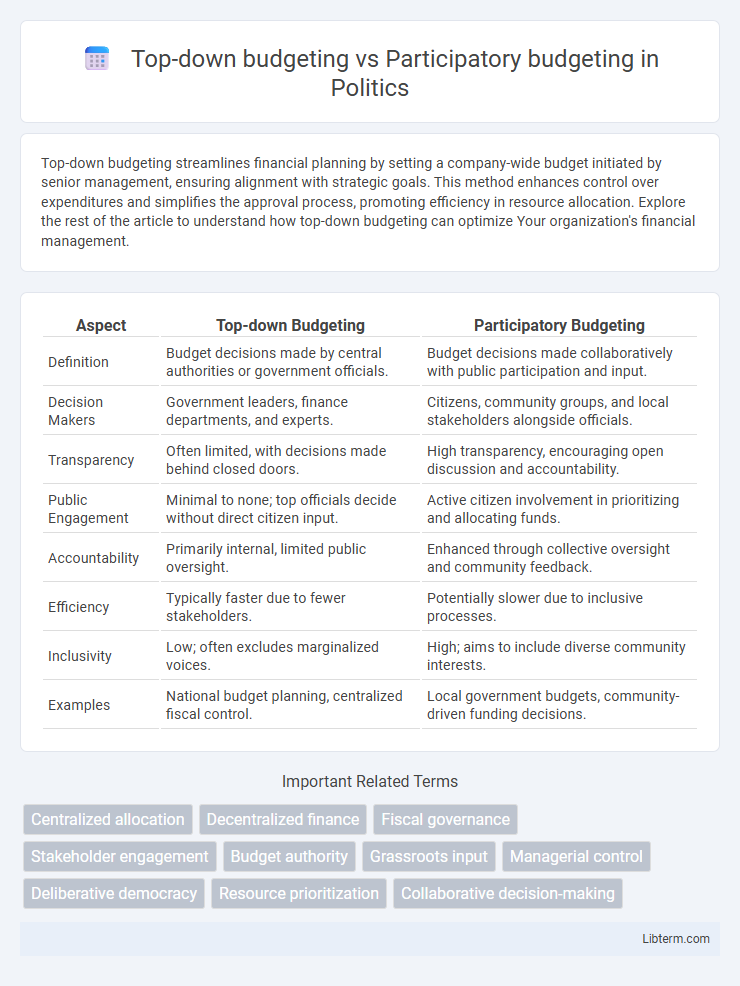Top-down budgeting streamlines financial planning by setting a company-wide budget initiated by senior management, ensuring alignment with strategic goals. This method enhances control over expenditures and simplifies the approval process, promoting efficiency in resource allocation. Explore the rest of the article to understand how top-down budgeting can optimize Your organization's financial management.
Table of Comparison
| Aspect | Top-down Budgeting | Participatory Budgeting |
|---|---|---|
| Definition | Budget decisions made by central authorities or government officials. | Budget decisions made collaboratively with public participation and input. |
| Decision Makers | Government leaders, finance departments, and experts. | Citizens, community groups, and local stakeholders alongside officials. |
| Transparency | Often limited, with decisions made behind closed doors. | High transparency, encouraging open discussion and accountability. |
| Public Engagement | Minimal to none; top officials decide without direct citizen input. | Active citizen involvement in prioritizing and allocating funds. |
| Accountability | Primarily internal, limited public oversight. | Enhanced through collective oversight and community feedback. |
| Efficiency | Typically faster due to fewer stakeholders. | Potentially slower due to inclusive processes. |
| Inclusivity | Low; often excludes marginalized voices. | High; aims to include diverse community interests. |
| Examples | National budget planning, centralized fiscal control. | Local government budgets, community-driven funding decisions. |
Understanding Top-down Budgeting
Top-down budgeting centralizes financial planning where senior management allocates the budget, setting fixed limits for departments based on organizational goals and overall revenue forecasts. This method streamlines decision-making and ensures alignment with strategic priorities, but may limit departmental flexibility and employee input. Understanding top-down budgeting involves recognizing its efficiency in controlling costs and maintaining fiscal discipline while potentially reducing the granularity of operational insights from lower levels.
What is Participatory Budgeting?
Participatory budgeting is a democratic process in which community members directly decide how to allocate a portion of a public budget, promoting transparency and civic engagement. Unlike top-down budgeting, where decisions are made solely by government officials or executives, participatory budgeting empowers citizens to propose, discuss, and vote on funding priorities. This approach fosters community involvement, enhances accountability, and often leads to more equitable resource distribution based on local needs.
Key Differences Between Top-down and Participatory Budgeting
Top-down budgeting involves decisions made by senior management with limited input from lower levels, emphasizing efficiency and control over resource allocation. Participatory budgeting empowers community members or employees to actively participate in decision-making, promoting transparency and inclusiveness. Key differences include the level of stakeholder involvement, decision-making authority, and the focus on either centralized control or democratic engagement.
Advantages of Top-down Budgeting
Top-down budgeting streamlines financial planning by allowing senior management to set clear priorities and allocate resources efficiently based on organizational goals. This approach accelerates decision-making processes, reduces the risk of budgetary conflicts, and ensures consistency across departments. It also facilitates compliance with strategic objectives, enhancing overall control and accountability within the enterprise.
Benefits of Participatory Budgeting
Participatory budgeting enhances transparency by actively involving community members in financial decision-making, leading to more equitable allocation of resources based on public needs. It fosters civic engagement and accountability, empowering citizens to prioritize projects that directly impact their neighborhoods and improve social outcomes. This inclusive approach often results in increased trust in government and more responsive, tailored public services compared to traditional top-down budgeting models.
Challenges of Top-down Budgeting
Top-down budgeting often faces challenges such as limited stakeholder engagement, which can lead to misalignment with local needs and priorities. It frequently results in reduced transparency and accountability, causing potential resistance from departments or communities excluded from the decision-making process. Furthermore, the rigid structure of top-down budgeting can hinder flexibility and responsiveness to unexpected changes or emergent issues within organizations or public sectors.
Common Limitations of Participatory Budgeting
Participatory budgeting often faces common limitations such as limited citizen engagement, which can lead to unrepresentative decision-making, and the complexity of managing diverse community interests within budget constraints. The process might also suffer from insufficient transparency and inadequate resources to implement chosen projects effectively. These challenges contrast with top-down budgeting, where decisions are centralized but typically more streamlined and resource-coordinated.
Real-world Examples and Case Studies
Top-down budgeting, exemplified by NASA's centralized project allocation, enables strict control and efficient resource distribution in large organizations, while participatory budgeting in Porto Alegre, Brazil, showcases citizen involvement improving transparency and addressing local needs. Studies on Seoul's participatory budgeting highlight increased public trust and tailored community projects, contrasting with New York City's top-down approach that streamlines extensive municipal operations. These real-world cases emphasize that participatory budgeting fosters grassroots engagement, whereas top-down models prioritize hierarchical efficiency in financial planning.
Choosing the Right Budgeting Approach
Choosing the right budgeting approach depends on organizational goals, stakeholder involvement, and decision-making speed. Top-down budgeting offers centralized control and faster execution, suitable for organizations prioritizing efficiency and clear accountability. Participatory budgeting enhances transparency and community engagement, ideal for projects requiring stakeholder buy-in and collaborative decision-making.
Future Trends in Organizational Budgeting
Future trends in organizational budgeting reveal a growing shift from traditional top-down budgeting towards participatory budgeting models that emphasize employee involvement and real-time data integration. Advances in artificial intelligence and blockchain technology are expected to enhance transparency, improve accuracy, and enable dynamic budget adjustments that align with organizational goals. Embracing collaborative budgeting approaches fosters innovation, agility, and a more inclusive decision-making process, positioning organizations to adapt swiftly in an evolving economic landscape.
Top-down budgeting Infographic

 libterm.com
libterm.com